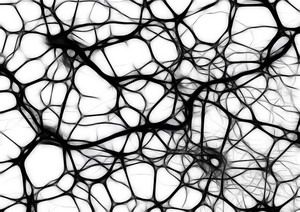
Do you say yes to life, or is your life one of limitations, inhibitions, and restrictions? This is not the simple question it appears to be. It is a question about the functional neurology between your ears.
These last couple months have been a personal education in neurology for me as I work with Ellen after her stroke. A lot of previously unobservable neurological processes become observable because of the level of brain tissue destruction that has taken place. Because of this, Ellen’s brain is having to start from scratch in various areas by recruiting brain cells that were doing other jobs and getting them to reassign themselves to take over for the now dead cells. In many ways it is like being a newborn baby in certain areas and functions. The biggest thing I am able to notice is the impact of fatigue on her function. More importantly, I get to see what types of things fatigue the brain immensely and what things do not.

Because certain functions in Ellen’s brain have only a few cells trying to do the job, anything that decreases the energy of those few cells is immediately obvious. With muscle testing we have gotten into the habit of checking what her physical energy level is. With her pre-stroke level defined as 100%, we muscle -test what percent her energy is at any given moment. This helps us quantify what we observe physically with her symptoms, like speed and slurring of speech, balance, and hip strength. Facial tone is also a big give-away as to her energy level. When her face muscles go limp, mouth sags, and eyes droop, you know she is pretty tired.
Now here is the interesting thing. We can be chatting along as I push her through the store on her wheel chair and her energy can drop significantly in a few moments. In a normal person we would not be able to notice this, as they have enough energy to compensate for this drop and cover it up. But right now with Ellen that extra energy is not there so we see these drops really easily. Now it is obvious that her physical energy levels would not drop that fast, so we have to look at other factors that would drop brain energy levels. And as the brain energy level drops, the energy to the tone muscles of her body also drops.

Fortunately we have muscle testing so that we can investigate what this energy drop is all about. What we have discovered is that when Ellen says “no” to life, her energy drops a lot. For example, as we were rolling through Costco to pick up a few things, we rolled by the coconut-covered macadamia nuts. I asked her if she would like some. She said she would love some but no, we shouldn’t get them because she would eat them all up and get fat. Shortly after that her energy tanked. She came across something that attracted her. Her brain lit up and her pleasure centers started to fire as she went into anticipation of having a coconut macadamia nut. Then her inhibitory neural center fired and shut down the brain activity to prevent a possible consequence that she did not want. The problem is that the energy in the middle of her brain anticipating the pleasure of the treat is the same energy that creates the tone in her muscles. Without this basic tone, her muscles are too weak to be able to move on her left side.
This pattern of neurology happens to us all the time. It is frequently the reason our backs go out. We engage in an activity that normally would be easy for us, but with our tone disrupted, our muscles don’t work right and we produce and injury. Normally we don’t notice this drop in muscle tone, but it is very real. A person’s strength can vary by over 50% from one moment to the next because of this tone shift in the postural muscles. In Ellen’s case, it even affects her movement muscles as well as her balance muscles. This all happens because of an inhibitory impulse to the midbrain by some part of us that is saying “no” to life. How often are you saying “no” to life?

But if we always say “yes” to life, won’t we end up wildly out of control as pleasure seeking hedonists? Won’t the very structure of civilized society break down? This is where the deep learning takes place. How do we say “yes” to life without ending up out of balance?
The answer lies in functionally: being able to distinguish between true physiologic pleasure and our ego’s desire for excitement. True physiologic pleasure, or what I call heart pleasure, is inherently balanced. The body loves balance above all things. In physiology we call this homeostasis. Anything that pulls us out of balance is felt as a bad thing and is unwanted. Our whole brainstem is dedicated to maintaining homeostasis – balance. It also has built into it mechanisms for controlled unbalance when this is needed to preserve the life of the organism individually and as a species. This is the 5F system: fight, flight, freeze, fornicate, and feed.

The ego, however, does not have the good sense to seek balance. It is created as a cognitive/action interface with the outer world that has the advantage of both remembering the past in detail and then projecting that information into speculations about the future in order to enhance our survival in this world. The problem is that the past and the future don’t exist except as pretend mockups inside our own heads. Only the present moment exists in the real world where we are connected to “what is.” The ego is inherently alone because of this. It feels itself separate from life because it spends its time functioning in the unreal mockup world of its projections. It is kind of like computer technicians that spend their entire lives in a world of electronic data and Internet realities. They lose touch with the real world and don’t relate well.
The ego has no sense of balance and thinks of itself as the center of the universe – because it is the center of its imaginary universe of projecting the past forward trying in order to figure out what the future will bring. In this narcissism, the ego wants to believe that it can get its own way in the world without consequence. Since it is tasked with making us safer by predicting the future, it feels it has a right to take control of everything in order to create the safer future it designs. It has no perception of how its actions will affect others, nor does it care until it has been beaten down with negative consequences and failures because of its narcissism. It also craves the excitement of anticipating being able to get what ever it wants in whatever amount it wants. This makes it feel like it is going to win. It has no upper limit for this excitement, and as we see in methamphetamine addicts, it will keep chasing the excitement even at the expense of the health of the body – the very thing it is supposed to be protecting.

So the trick to saying “yes” to life is to say it from your heart, not your ego. Your heart will say “yes” in the amount that keeps you balanced. Your ego will end up abusing you by saying “yes” in excess. Will eating a coconut covered macadamia nut make you fat? No it won’t, but eating the whole can might. The heart wouldn’t do that. It would feel messages from the body telling it when enough is enough and it would tell you to stop. But the ego would eat the whole can. It likes getting its way and it hates the signals from the body that interfere with its agenda. It deals with these body signals by using drugs, foods, and behaviors that numb the body and shut down these feedback signals. Sugar, alcohol, nicotine, prescription meds, pain killers, over eating, under eating, over work, distractions, all of these numb the body and keep the balancing signals turned down so the ego does not have to listen to them.
There is one last concept I want to introduce here. This has to do with the interconnectedness of the neurons in the brain. I believe that neural interconnectedness and spiritual growth are two sides of the same coin. Life is defined by its complexity. We are complex evolving forms creating ever-greater levels of self-complexity. Life opposes the natural order in the universe for everything to wind down to its simplest form and lose energy. This is called entropy. Life is anti-entropic. That is its definition.

We are designed to self create, because we are life. We are human because we connect and form community. The challenge is to do both simultaneously. Ego wants to create. The heart wants to connect. But creation is infinitely easier if we are able to do everything our way. With connection we have to figure out how to harmonize all the differences between all of us; the seeming exact opposite of doing things our way. Ego wants to be the center of everything in order to create the safety it has been tasked with. But it tries to do this alone – from a state of separation. But the deep reality is that humanity has created its safety through its community-forming-group efforts. One warrior’s skill against the dangers of the wild is good, but one hundred warriors all working together does a lot better at creating safety.
There is a narrow path – a set of choices and skills that evenly combines both connection and self-creation. It is a path that involves ever greater levels of complexity and skill. Complexity and skill are seen in the brain as increasing interconnectedness between the neurons. We literally bring more brain cells to the job of solving each problem we face. This happens when these brain cells are all connected together. The more interconnectedness we have, the brighter we become. We get more creative. We get more sensitive. We get bolder and more confident. We get more discriminative. We get more intuitive and also more logical. We come to appreciate and love and be joyful in our dealings with life. This is what I call spiritual tone. As our brain gets more interconnected, we think and feel more with our whole brain and this is what I call the raising of our spiritual tone. Just like the muscles of the body that depend on the firing of the nerves in the midbrain to have the tone they need to be able to move and balance, our life needs the firing of the whole brain to produce the tone necessary to navigate life successfully.

We resist this path of building spiritual tone because it is work. It is the most basic work we do as humans: form new neural connections. Staying inside our “box” and staying comfortable is how we resist this work. Stepping out of our box and finding new ways and new solutions and new connections is the work of life. It is spiritual growth. It is the reason for being alive in my view.
Do I have the spiritual tone, the brain connections, the freedom and balance of thought and feeling to move forward in my life, or am I slowly slipping into comfortable degeneration? There is no standing still on the path of life because everything is always moving around us. We are either moving and adapting to the changing environment or we are sliding downhill into obsolescence. Am I alive, or am I just slowly dying?
